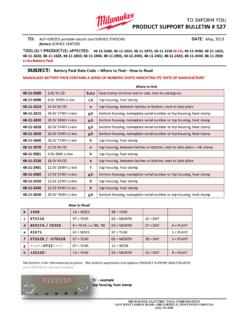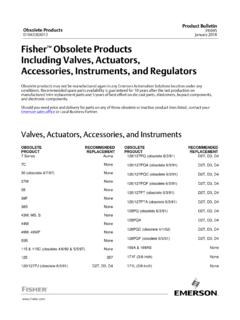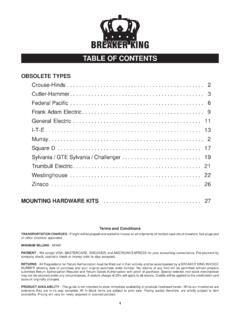Transcription of Molded-Case Circuit Breakers - Eaton
1 Volume 12 Aftermarket, Renewal Parts and Life Extension SolutionsCA08100014E October Circuit BreakersMolded-Case Circuit Breakers Family3 Molded-Case Circuit BreakersProduct Description, History, Major product Introduction .. V12-T3-2 General Information.. V12-T3-3 Nameplate Data .. V12-T3-3 Identifying Factory Original Circuit Breakers .. V12-T3-4 Replacement and Upgrade Options .. V12-T3-5 Replacement GuidesMiniature Circuit Breakers .. V12-T3-6 Molded-Case Circuit Breakers .. V12-T3-10 Replacement DevicesCircuit Breakers .. V12-T3-15 Molded-Case Switches .. V12-T3-61 Motor Circuit Protectors .. V12-T3-63 Accessories .. V12-T3-63 Panelboard Replacement Breakers .. V12-T3-80 Replacement Guide .. V12-T3-81 Motor Control Center Replacement Breakers .. V12-T3-88 Technology Upgrades for Circuit Breakers .. V12-T3-91 Handle Mechanisms .. V12-T3-95 Replacement and Service Capabilities .. V12-T3-112 Cross-ReferenceWestinghouse, Challenger and Bryant Replacements.
2 V12-T3-113 Breaker Replacements .. V12-T3-115 Mining Breaker Replacements .. V12-T3-162 Pricing Information .. V12-T3-168V12-T3-2 Volume 12 Aftermarket, Renewal Parts and Life Extension SolutionsCA08100014E October Circuit BreakersMolded-Case Circuit BreakersMolded-Case Circuit Breaker FamilyProduct DescriptionEaton s Molded-Case Circuit Breakers are designed to provide Circuit protection for low voltage distribution systems. They are described by NEMA as ..a device for closing and interrupting a Circuit between separable contacts under both normal and abnormal conditions, and furthermore as ..a breaker assembled as an integral unit in supporting an enclosed housing of insulating material. The NEC describes them as .. a device designed to open and close a Circuit by non-automatic means, and to open the Circuit automatically on a predetermined overload of current, without injury to itself when properly applied within its rating.
3 Circuit Breakers protect against overloads in conductors and protects against short circuits in connected apparatus such as motors and motor Breakers are designed for use in panelboards, switchboards, motor control centers, control panels, combination starters, individual enclosures and bus duct plug-in HistoryOriginally a Westinghouse ProductThe need for Molded-Case Circuit Breakers came about in 1918 when numerous applications for electrical motors resulted in a demand for a device that would ensure safe operation and, at the same time, protect electrical this period, individual motors were used for the first time in industrial plants to operate machine tools and in private homes to operate appliances. Plant electricians were constantly changing fuses blown during motor startups because of the lack of properly designed fuses for motor Circuit protection. Homes experienced similar problems when electrical circuits were overloaded.
4 Inspectors were concerned about fire hazards because of plug fuses being bridged with pennies and the installation of fuses with too high an ampere authorities became involved and attempted to find a solution to the problem. Meetings with switch manufacturers were initiated in an effort to find a solution. Switch manufacturers were asked to develop a switching device that would interrupt a Circuit under prolonged overload conditions. The device would have to be safe, reliable and tamperproof. It should also be resettable so as to be reusable after an interruption without replacing any parts. This search for better Circuit protection resulted in many different but unacceptable approaches to the problem. These early meetings and subsequent efforts prepared the groundwork for the eventual development of the Molded-Case Circuit intensive research and development, Westinghouse produced the DE-ION arc extinguisher for use in large oil Circuit Breakers .
5 Although too large in its initial form to be practical for small Circuit Breakers , the arc extinguisher was eventually modified into a usable size. The first compact, workable Circuit breaker was developed in 1923 when the modified arc extinguisher was coupled with a thermal tripping mechanism. It was not until four years later, however, that Westinghouse research engineers found the ideal combination of materials and design that permitted Circuit Breakers to interrupt fault currents of 5000A at 120 Vac or Vdc. One year later, Westinghouse placed the first Circuit breaker on the market. Its acceptance was that initial introduction in 1927, Westinghouse continued to be at the forefront of Circuit breaker technology with an unprecedented series of Circuit protective enhancements and introductions as chronicled below. In 1994, Eaton , another world-class technology leader, acquired the Westinghouse Distribution and Control Business Unit (DCBU) and integrated it with their Cutler-Hammer business unit forming a powerful, new combination, poised to meet the challenges of the next 100 Line Major product Introductions 1923 First compact, workable Circuit breaker developed by Westinghouse 1927 Westinghouse introduced the first complete Circuit breaker line, rated 10 600A, 600V 1939 Along with ordering information and style numbers, the various maximum current ratings came to be known by frame designations.
6 50A E-Frame 100A F-Frame (non-interchangeable trip) 100A G-Frame 225A K-Frame 600A L-Frame 1970 Motor Circuit Protector (MCP) introduced first sensitive, low level protection designed specifically for motor circuits 1973 SELTRONIC introduced first Molded-Case Circuit breaker with an electronic trip unit 1979 Current Limit-R Circuit breaker introduced first true current limiting trip unit 1982 Series C Family introduced new world-class standard, meeting increasing interrupting requirements without sacrificing compact size 1994 Westinghouse Distribution and Control Business Unit (DCBU) acquired by Eaton , integrated with Cutler-Hammer (the Cutler-Hammer line of molded case Circuit Breakers was sold when merged with Westinghouse) 1995 OPTIM Family introduced first truly programmable Molded-Case Circuit breaker 2002 Next Generation E125, J250 2004 Series G First Global Breaker LineYearProduct1920 1930 194019501960197019801990199520002002 PresentVolume 12 Aftermarket, Renewal Parts and Life Extension SolutionsCA08100014E October Circuit BreakersBreaker IdentificationNameplate DataA Circuit breaker is identified by data found on the includes: Catalog number Shop order number Style number Amperage Number of poles Voltage class Temperature ratingIn most instances, the catalog number, style number or shop order number will supply enough informationto identify the Circuit breaker.
7 However, it is always advisable to obtain all data from the nameplate to facilitate Catalog Number begins with a series of letters followed by numbers that identify: Circuit breaker type Number of poles Maximum amperage Example: Catalog number F3020 indicates a Type F Circuit breaker, three poles, 20AA Shop Order Number begins with one or two numbers followed by a single letter and four additional shop order number is listed in place of a catalog number and indicates that the Circuit breaker was modified at the factory, , addition of a shunt trip, special calibration, etc. Every shop order number must be researched with the factory to properly identify modifications. Call your Cutler-Hammer Field Sales office for this information. Example: 70E2121 Note: Eaton does not recommend replacing a Circuit breaker identified by a Shop Order Number with a standard off-the-shelf Circuit breaker without first identifying the modifications.
8 They may be critical to safe and reliable Circuit breaker accessories are mounted internally and are not visible with a quick inspection. However, because many accessories rely on or supply an external signal, there may be electrical leads exiting the Circuit breaker case. Inspect for these leads when obtaining full descriptive information for Circuit breaker replacement. Examples of common accessories:Shunt TripUsed to remotely trip the Circuit breaker using an electrical signal. Typically two wires extend through the Release (UVR)Trips the Circuit breaker when voltage drops below a specified percentage of coil voltage (typically 70%). Typically two wires extend through the SwitchProvides remote indication of the Circuit breaker status (open/closed). Typically three wires extend through the case in a single-pole 1A/1B Lockout SwitchFor remote indication of an automatic trip operation. Typically two or three wires extend through the C Breaker with Original Label (Labels updated in 1997)Series C Breaker with Original Label (Labels updated in 1997)Vintage Label for Typical SELTRONIC Molded-Case Circuit BreakerV12-T3-4 Volume 12 Aftermarket, Renewal Parts and Life Extension SolutionsCA08100014E October Circuit BreakersFactory Original Circuit BreakersWhy Insist on Only Genuine, New MCCBs Purchased Through Authorized Distributors?
9 Eaton defines New product as that which has not yet been installed in an electrical Circuit , purchased through authorized channels in factory original condition and packaged in unopened Eaton cartons. The only way to ensure safe and reliable operation of your system is to use genuine, new, Eaton s Cutler-Hammer products exclusively. Eaton does not resell the component parts for Molded-Case Circuit Breakers , the only way for third-party breaker refurbishers to get parts for the Breakers that they are rebuilding is to cannibalize other used Breakers or to use counterfeit components. Neither is a very good option for the end user In some cases, unauthorized resellers of Molded-Case Circuit Breakers have been found to misrepresent used, rebuilt or surplus products. Only products purchased as new through authorized channels are covered under the Eaton warranty policy There have been instances where third-party refurbishers have rebuilt Breakers using the wrong parts, with parts missing or the factory lubrication removed in the cleaning process any of which may result in devices that may not be depended upon to function properly to protect equipment and personnelIdentifying Genuine, Factory Original Westinghouse Circuit Breakers Manufactured by EatonThe features on a Molded-Case Circuit breaker that identify it as genuine or counterfeit may or may not be readily apparent.
10 In fact, there may be differences not detectable by an external genuine Eaton brand Molded-Case Circuit breaker manufactured by Eaton will have a serialized bar code unique to the breaker as well as an unbroken seal where the case comes together. This barcode and seal were placed at the factory and ensures the internal integrity of the breaker. If, for any reason the barcode is missing or the seal is broken, do not accept the breaker. (Seal does not appear on interchangeable trip Breakers .)Unbroken SealThere is a manufacturing date code on the back of genuine Molded-Case Circuit Breakers stamped in silver and white. If this coding is missing, it may mean the breaker has been subjected to tampering. Frequently, this date code is wiped off in an attempt to represent the breaker as Date CodeAnother way to tell if a breaker has been tampered with is to examine the sealant used to cover the screws on the top rear of the breaker.















